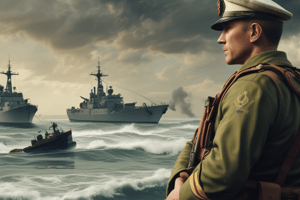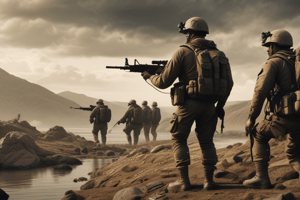Podcast
Questions and Answers
What was the original purpose of the Royal Marines when they were founded?
What was the original purpose of the Royal Marines when they were founded?
- To conduct naval engineering
- To provide shipboard defense and conduct amphibious assaults (correct)
- To serve as naval officers
- To operate submarines
During which conflict did the Royal Marines notably participate in the Battle of Trafalgar?
During which conflict did the Royal Marines notably participate in the Battle of Trafalgar?
- The Cold War
- The Napoleonic Wars (correct)
- World War I
- The American Revolutionary War
In which campaign during World War I were the Royal Marines engaged?
In which campaign during World War I were the Royal Marines engaged?
- Gallipoli Campaign (correct)
- The Battle of Verdun
- The Battle of the Somme
- The Western Front (correct)
What is a key characteristic of the modern role of the Royal Marines?
What is a key characteristic of the modern role of the Royal Marines?
What does the motto 'Per Mare, Per Terram' signify about the Royal Marines?
What does the motto 'Per Mare, Per Terram' signify about the Royal Marines?
Which of the following best describes the training the Royal Marines undergo?
Which of the following best describes the training the Royal Marines undergo?
How did the Royal Marines adapt during the Cold War?
How did the Royal Marines adapt during the Cold War?
What symbolizes the elite status of the Royal Marines?
What symbolizes the elite status of the Royal Marines?
Flashcards are hidden until you start studying
Study Notes
Early Formation
- Founded: The Royal Marines were established in 1664 as the Duke of York and Albany's Maritime Regiment of Foot.
- Original Purpose: Created to serve as sea soldiers, providing shipboard defense and conducting amphibious assaults.
Key Historical Milestones
- 17th Century: Involved in various naval battles during the Anglo-Dutch Wars.
- 18th Century: Played a significant role in the American Revolutionary War and various colonial conflicts.
- 1800s: Became noted for their actions during the Napoleonic Wars, particularly at the Battle of Trafalgar (1805).
20th Century Developments
- World War I: Engaged in land operations, including the Gallipoli Campaign (1915) and on the Western Front.
- World War II: Contributed significantly to numerous campaigns, including D-Day and the Pacific War.
- Post-War Role: Transitioned to a peacekeeping role, participating in various conflicts and peacekeeping missions worldwide.
Modern Era
- Cold War: Adapted to new military strategies and technologies, including counter-insurgency operations.
- Recent Deployments: Involved in Iraq and Afghanistan, specializing in counter-terrorism and rapid response operations.
- Current Role: Continues to serve as an elite amphibious force within the UK Armed Forces, focusing on versatility and global reach.
Organizational Structure
- Command: Part of the Royal Navy, with a close relationship to naval operations.
- Training: Known for rigorous training at the Commando Training Centre, including the infamous Commando Course.
Notable Features
- Insignia: The Green Beret is a symbol of the Royal Marines’ elite status.
- Motto: "Per Mare, Per Terram" (By Sea, By Land), reflecting their dual capability.
Cultural Impact
- Media Representation: Featured in numerous films, documentaries, and literature showcasing their exploits and ethos.
- Public Perception: Renowned for their discipline, resilience, and operational effectiveness.
Early Formation
- Established in 1664 as the Duke of York and Albany's Maritime Regiment of Foot.
- Designed to function as sea soldiers for shipboard defense and amphibious assaults.
Key Historical Milestones
- Active in the 17th century during the Anglo-Dutch Wars, participating in notable naval battles.
- Significant involvement in the American Revolutionary War and colonial conflicts during the 18th century.
- Gained recognition in the 1800s for their role in the Napoleonic Wars, particularly at the Battle of Trafalgar (1805).
20th Century Developments
- Engaged in land operations in World War I, notably in the Gallipoli Campaign (1915) and on the Western Front.
- Played a crucial role in World War II, with significant contributions during D-Day and in the Pacific War.
- Post-war, shifted focus to peacekeeping roles, engaging in various global conflicts and missions.
Modern Era
- During the Cold War, adapted to evolving military strategies and technologies, focusing on counter-insurgency operations.
- Recent deployments include active participation in Iraq and Afghanistan, specializing in counter-terrorism and rapid response.
- Currently recognized as an elite amphibious force within the UK Armed Forces, emphasizing versatility and global reach.
Organizational Structure
- Integrated into the Royal Navy, maintaining a close relationship with naval operations.
- Rigorous training conducted at the Commando Training Centre, highlighted by the demanding Commando Course.
Notable Features
- The Green Beret symbolizes the elite status of the Royal Marines.
- The motto "Per Mare, Per Terram" (By Sea, By Land) exemplifies their dual operational capabilities.
Cultural Impact
- Frequently represented in films, documentaries, and literature that highlight their exploits and ethos.
- Public perception reflects their discipline, resilience, and effectiveness in operations.
Studying That Suits You
Use AI to generate personalized quizzes and flashcards to suit your learning preferences.




